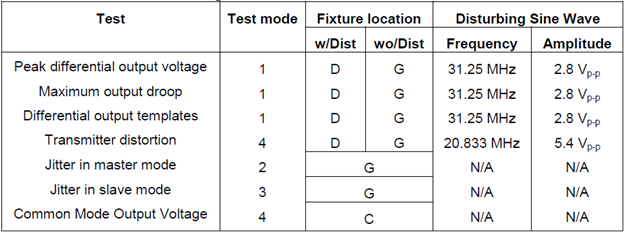Relevant Documents
 (215KB)
(215KB)
Background
The testing of Ethernet-based devices – supporting the 10Base-T, 100Base-TX, and 1000Base-T standards – is defined in the IEEE 802.3-2005 and ANSI X3.263-1995 standards.
Support for four test modes is required in the physical layer of the device-under-test (DUT). A disturbing sine wave is required for modes 1 and 4. The frequency and amplitude of the sine wave specified for each mode are listed in the following table:

Figure 1: Gigabit Ethernet Tests and Modes
An important prerequisite for testing is disturber calibration, in which we measure the amplitude of a disturbing sine wave being applied to the DUT. The calibration is required to adjust the amplitude of the disturbing sine wave, which is generated by a dual-channel arbitrary waveform generator (AWG).
Requirement
The testing modes requiring use of a disturbing signal are detailed below. Note that the two output signals generated by the AWG must have the same amplitude, but are generated with a 180-degree phase shift.
Mode 1 Disturbing Signal

Mode 4 Disturbing Signal

Solution
Tabor Electronics’ Wave Standard family of Arbitrary Function Generators (AFGs) serves as an excellent platform for Ethernet Disturber Calibration, with dual-channel waveform generation capability, and a sampling rate of 250 MS/second.
Wave Standard incorporates both a built in waveform gallery and modulation schemes for easy and fast generation of standard waveforms, as well as a memory-based true AWG architecture that allows you to quickly create and edit complex waveforms.
Wave Standard is supplied with ArbConnection – Tabor’s comprehensive software tool that controls AWG operation, and supports the creation of unique, arbitrary waveforms using its powerful Waveform Composer.
For More Information
To learn more about Tabor’s solutions or to schedule a demo, please contact your local Tabor representative or email your request to [email protected]